Determining Grazing Readiness for Native and Tame Pastures (R1061, Revised May 2018)
Availability: Web only
One of the most important grazing management decisions land managers make is selecting a start date for grazing tame pasture and native range.
Land managers need to monitor to make sure forage is ready to be grazed prior to livestock turning out. Starting grazing too early reduces plant leaf area for photosynthesis that is needed to replace carbohydrates depleted during the winter and green-up. Plant vigor is reduced, stands are thinned, total forage production is lowered, and disease, insect and weed infestations are increased.
Grazing too early can be costly in terms of total forage production during the entire grazing season. Grazing before grass plants reach the grazing readiness phase causes a reduction in herbage production, which can reduce stocking rate and animal performance.
Pastures and range damaged by grazing too early may take several years of deferment or even rest before the stand regains productivity. On the other hand, starting grazing too late increases forage loss and waste through trampling or reduced palatability, and increases the presence of exotic cool-season grasses such as Kentucky bluegrass and smooth bromegrass.
Land managers generally base grazing readiness or time to begin grazing on calendar dates. This may be the right decision some years, but each year is different with respect to the earliness or lateness of spring, so the calendar date method may not always coincide with the best time to graze.
Plant development can vary greatly between locations. (NDSU photos)
McLean County – Date: 4/20/17
Smooth Bromegrass – 2 1/2-leaf stage
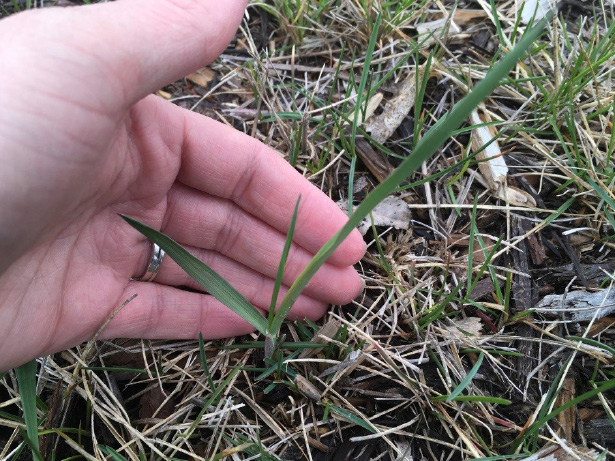
Grant County – Date: 4/19/17
Smooth Bromegrass – 3 1/2-leaf stage
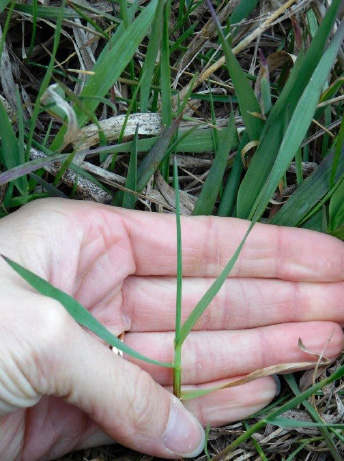
Plant development (not growth) can vary greatly between years. (NDSU photos)
Oliver County – Date: 5/14/18
Western Wheatgrass – 1 1/2-leaf stage
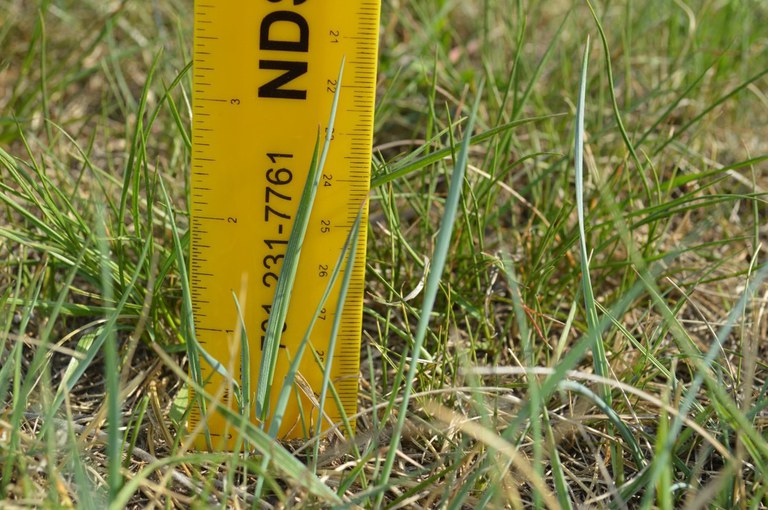
Oliver County – Date: 5/9/17
Western Wheatgrass – 3 1/2-leaf stage
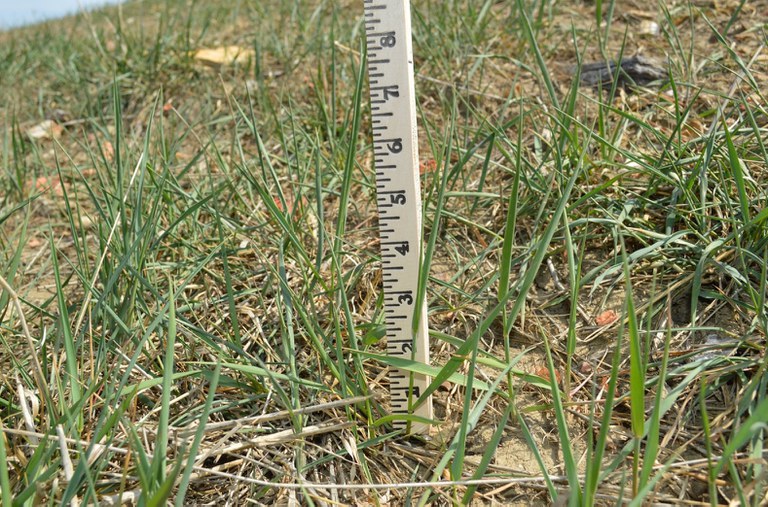
The timing of grazing readiness depends on a number of factors, including the species of grass, available moisture, weather and past management. As a result, the exact timing of grazing readiness can vary across a state.
We recommend that grazing readiness be based on the developmental stage of the most common or key grass species in the pasture or range. The recommended plant development stage to begin grazing for most domesticated pasture is at the three-leaf stage, whereas grazing readiness for most native range grasses is the 3½-leaf stage.
Plant Development
Understanding the difference between plant development and plant growth is important for determining grazing readiness. Development refers to the formation of plant structures, such as leaves, in an orderly and consistent pattern. Plant growth is the accumulation of forage dry matter or the expansion of leaves and stems.
Grass plants develop in an orderly and consistent manner. Leaves are the major plant organ of interest for grazing. A new leaf becomes visible on a plant after the one preceding it is almost fully developed. The calendar time at which the first leaf appears and the rate at which each leaf develops is determined by the amount of thermal (heat) energy available for biological activity.
The air temperature on any spring day differs from year to year, so the amount of heat energy available for plant development for any calendar date, hence development stage, also will vary from year to year.
For determining grazing readiness, we are most interested in the number of leaves formed on the plant. A correlation between development and growth is obvious. Thus, from a management viewpoint, initiating grazing at a specific development stage can be repeated each year, whereas initiating grazing at a growth stage would be difficult.
Development Stage Scales
The developmental stage scale most commonly used in North Dakota is the Haun plant development stage scale. This scale was created to determine cereal crops from emergence to grain harvest for the proper timing of herbicide and fertilizer applications. For determining grazing readiness of grasses, we are interested only in plant vegetative development that occurs prior to head formation.
The Haun developmental scale is an easy-to-use scale to determine the developmental stage of forage grasses. This scale is a numerical expression of the number of leaves produced on a main stem.
Most cool-season grass plants produce a maximum of six leaves on stems before reaching the reproductive stage or produce a head. Plants that remain vegetative will continue to produce leaves if water is available. Fewer than six leaves may be produced if plants are under severe water, nutrient or high-temperature stress.
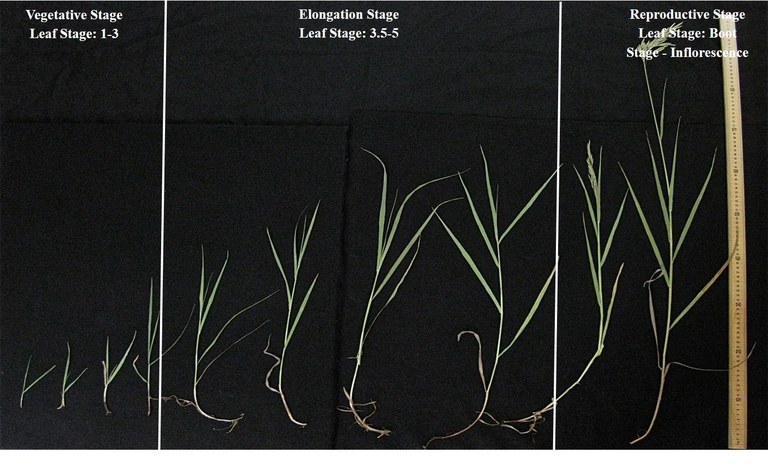
This photo represents the morphological stages smooth brome transitions through; the vegetative stages of one- to three-leaf stage, elongation stage of three- to five-leaf and reproduction stage of the boot stage (five-leaf) to full inflorescences developed (Dupey, 2014).
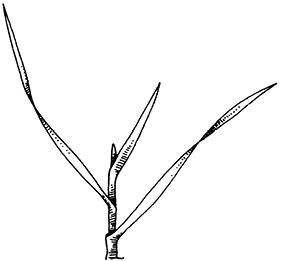
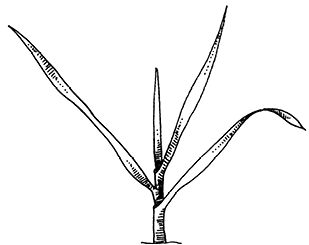
Figure 1. (left) This is a grass plant that has three fully developed leaves, so the Haun growth stage is 3.0. For crested wheatgrass, this stage requires an accumulation of 443 growing degree days (GDDs). (right) This is a grass plant that has three fully developed leaves and the fourth, which is half as long as the third leaf, so the Haun growth stage is 3.5. For green needlegrass, this stage requires an accumulation of 1,209 GDDs.
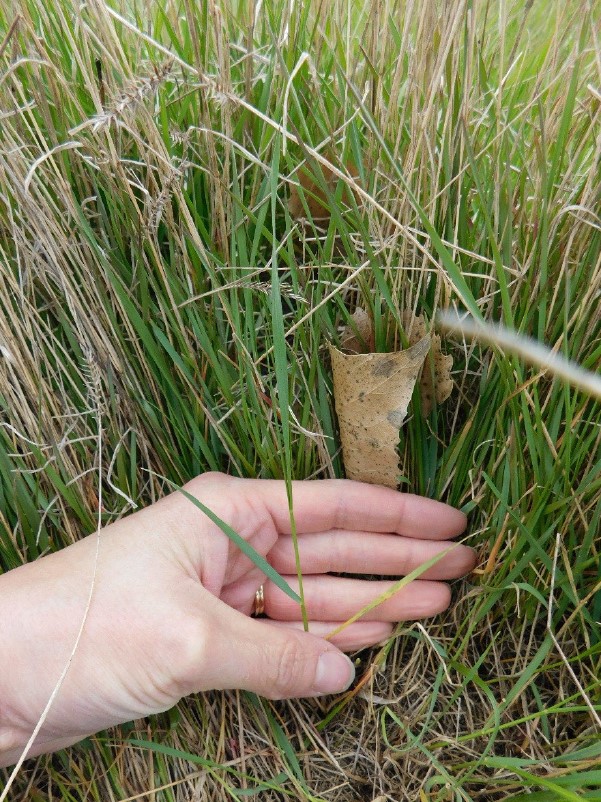
Crested wheatgrass at the three-leaf stage. (NDSU photo)
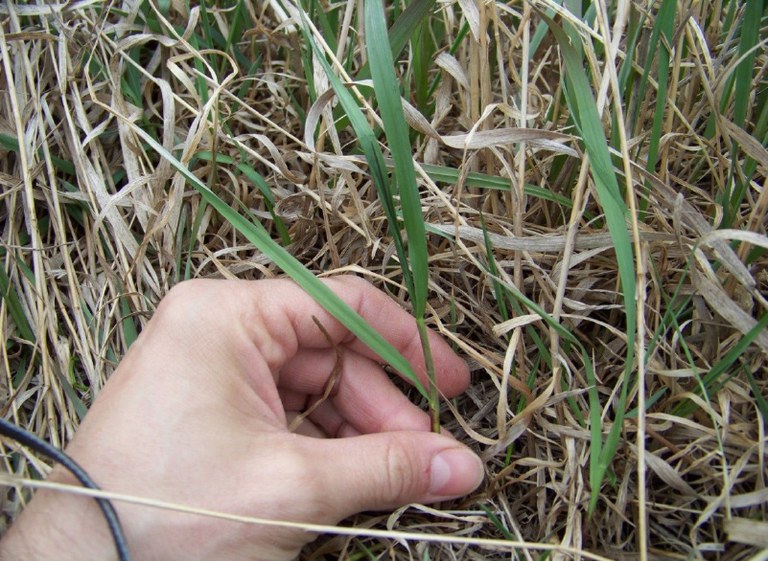
Smooth bromegrass at the three-leaf stage. (NDSU photo)
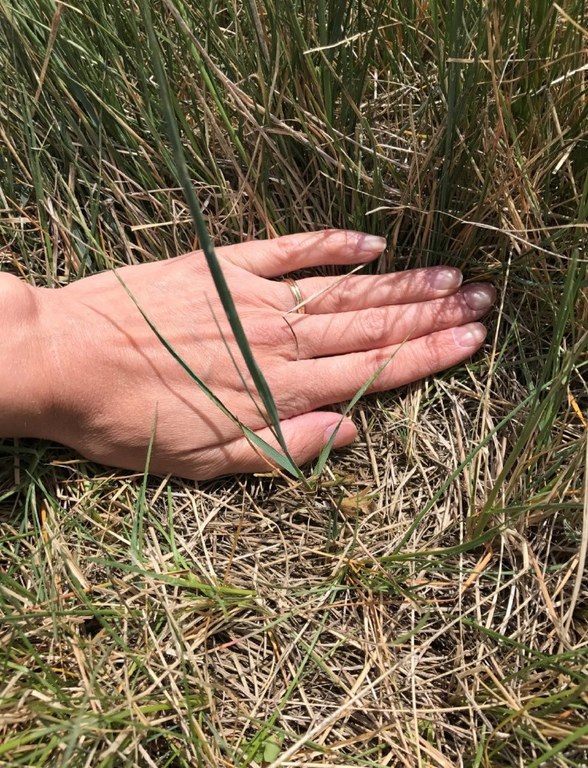
Western wheatgrass at the 3½-leaf stage. (NDSU photo)
Calculating Growing Degree Days
Air temperature is the main environmental factor that determines the rate of plant development. Each leaf produced on a stem requires a specific amount of accumulated heat, or heat units. The temperature when plants initiate development, or the base temperature, is 32 F for cool-season and 40 F for warm-season grasses.
The temperature or heat units that a plant needs to accumulate to produce a leaf can be expressed as growing degree days, or GDDs. For any calendar day, the number of GDDs for that day is the average of the hourly minimum and hourly maximum temperature in the same 24-hour period minus the base temperature.

Accumulating Growing Degree Days
The daily GDDs are totaled to determine the total GDDs accumulated from the initiation of spring growth to any other date. As a point of reference, the GDDs accumulated at Bismarck from April 1 to June 30 for 1981 to 2010 are shown in Table 1.
Table 1. The daily GDDs calculated from the average daily temperature for the 1981-2010 period at Bismarck, N.D. GDDs were calculated using 32 F as the base temperature.

The date to start recording temperatures for calculating GDDs to determine development stage of perennial forage grasses is quite different than for cereals. In cereals, emergence dates are determined easily, but in perennial grasses, the time that growth and development begin in the spring is less obvious. Research at Mandan determined that the time to start accumulating GDDs is on the first day after March 15 that the average daily air temperature (daily maximum + daily minimum ÷ 2) exceeded 32 F for five consecutive days.
To show how to use Table 1, let’s calculate the GDDs on May 5. Because we started recording GDDs on April 1 and the average daily air temperature exceeded 32 F for five consecutive days, we can add all GDDs from April 1 to May 5 (5 + 6 + 6 ... + 20 + 20). The total GDDs for this time period is 453.
At 453 GDDs, needle-and-thread is in the Haun stage 1.5 and crested wheatgrass is approaching Haun stage 3.0 on May 5. Based on range readiness, the crested wheatgrass is ready to be grazed on May 5, but the needle-and-thread is just reaching the half-way point in readiness.
Growing Degree Days and Grazing Readiness
The GDDs needed to produce each leaf on some common tame and native forage grasses determined from regression analysis of accumulated GDDs and Haun stage are shown in Table 2.
Table 2. Growing degree days required for some native and tame grasses to develop to Haun stages 1 through 5.

Example
How to determine when to begin grazing a pasture in which green needlegrass is one of the key forage species: The Haun development stage to begin grazing green needlegrass is 3.5. From Table 2, we see that green needlegrass requires 1,209 GDDs to reach Haun stage 3.5. Calculating GDDs from actual weather data as described earlier is best, but for this example, we can use the GDDs from Table 1.
From Table 1, which is based on the 1981-2010 period, we see by totaling the GDDs that 1,209 GDDs would be accumulated by June 5. Therefore, from this example, using green needlegrass as the key grass on which to base our decision, grazing could start about June 5.
The date when using other native grasses such as key grasses to reach Haun stage 3.5 would be needle-and-thread, May 29; prairie Junegrass, May 20; and western wheatgrass, June 4. Blue grama, a warm-season grass, reached Haun stage 3.5 on June 25, using 40 F as the base temperature.
Tame cool-season grasses require fewer GDDs to form a leaf; therefore, they can be grazed earlier than native grasses. Using Table 2 and following the same procedures as above, Nordan crested wheatgrass requires 443 GDDs to reach Haun stage 3 (three-leaf stage), which occurred on May 6; intermediate wheatgrass needed 675 GDDs (May 16); and Rodan western wheatgrass needed 535 GDDs (May 14). The difference observed between native prairie western wheatgrass and Rodan western wheatgrass (selected eco-variety) is due to selection by plant breeders for early development in Rodan.
The recommended growth stage for beginning grazing on tame and native pastures is the three- and 3.½-leaf stage, respectively, which coincides with Haun stages 3 and 3.5, respectively (Figures 1 and 2).
Recordkeeping
The GDD method requires the following recordkeeping to determine plant development stage:
- Record the daily maximum and minimum temperatures and calculate the daily GDDs. Temperatures usually can be obtained from weather reports on the local radio station, newspapers (recordkeeping sheet supplied) and North Dakota Agricultural Weather Network (NDAWN) website.
- Determine the starting date for calculating GDDs, which is the first day after March 15 that the average daily air temperature (daily maximum + daily minimum ÷ 2) exceeds 32 F for five consecutive days. If the average daily temperature is less than 32 F, no GDDs are accumulated for that day. This date normally will be about April 1 in southern and April 10 in northern North Dakota.
- Accumulate the GDDs for each day from the starting date.
- Use Table 2 to determine the GDDs required for the key species to reach Haun stage 3 (tame) or 3.5 (native); at this stage, the pasture is ready for grazing.
- Visit the pasture about every week during this period to become more familiar with grass development. By counting the number of leaves and determining the Haun stage, and by making comparisons to the GDDs accumulated to that date, managers will better understand the relationship between GDDs and grazing readiness.
Conclusion
Monitoring the grazing readiness of your pastures prior to turnout is important. If grazing starts at the proper developmental stage, the plants will be more tolerant of grazing stress and will maintain the higher vigor needed to continue forage production during the grazing season and following years.
The ecological and economic impacts of grazing native rangeland prior to grazing readiness may lead to years of recovery if livestock are allowed to overgraze. Monitoring the developmental stage of key grass species is the most reliable method of determining grazing readiness.
However, using the GDD approach to determine grazing readiness can minimize the guesswork of when grazing can begin on any pasture. Because the spring season and grazing readiness vary from year to year, the GDD approach will help you determine the best date to begin grazing.
Source:
Frank, A.B., J.D. Berdahl and R.E. Barker. 1985. Morphological development and water use in clonal lines of four forage grasses. Crop Sci. 25:339-344.
Frank, A.B., and L. Hofmann. 1989. Relationship among grazing management, growing degree-days, and morphological development for native grasses on the northern Great Plains. J. Range Manage. 42:199-202.
Frank, A.B., and R.E. Ries. 1990. Effect of soil water and nitrogen on morphological development of crested and western wheatgrass. J. Range Mange. 43:255-258.
This publication was authored by Kevin K. Sedivec, rangeland management specialist, NDSU; Albert B. Frank, plant physiologist, Agricultural Research Service, U.S. Department of Agriculture, Mandan, N.D.; and Lenat Hofmann, research agronomist, Agricultural Research Service, USDA, Mandan, 1993.

Revised May 2018


